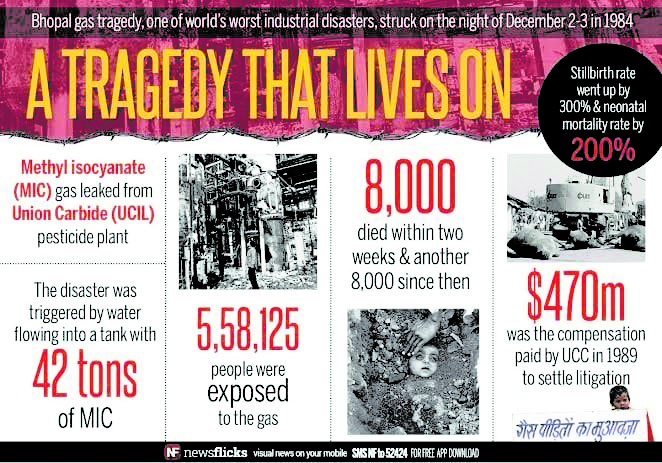In 1984, the capital city of Madhya Pradesh was struck by an enormous industrial catastrophe, regarded as the deadliest in history. This tragedy unfolded due to a chemical leak at a Union Carbide Pesticides plant. The loss of thousands of lives and severe injuries suffered were the result of negligence by a few. The Bhopal Disaster exposes the inefficiencies of state entities, the judiciary, and the administration.
This catastrophe didn’t merely impact people in 1984; its ramifications persist in affecting the health of individuals to this day. Multiple human rights, including the right to life, health, non-discrimination, and remedy, have been violated for the residents of Bhopal. Any corporation or industry holds a corporate social responsibility, and Union Carbide Corporation (UCC) clearly breached and surpassed this responsibility by causing harm to the environment and people’s lives.


The incident garnered national and international attention, raising crucial questions about corporate and social accountability. Within days of the gas leak, 7,000 people were found dead, with over 15,000 succumbing in the subsequent years. Approximately, a hundred thousand individuals continue to suffer from chronic illnesses, for which treatments have proved largely ineffective.
This disaster underscores the urgent need for the development of comprehensive internal human rights laws that can be directly applied to corporations. Such laws could serve as a benchmark, encouraging the formulation of domestic laws in this regard. Measures like soliciting public opinion when making critical decisions regarding any establishment—such as location and waste management—can prove instrumental in preventing and averting disasters akin to the Bhopal Gas Tragedy.
History
In the 1970s, the Indian government actively pursued policies to encourage foreign investments in local industries. Sevin, a widely used pesticide in Asia, led the Union Carbide Corporation (UCC) to establish a plant in response to this initiative. Interestingly, the Indian government held a 22% stake in the company’s subsidiary, with the majority of shares owned by local shareholders. Given Bhopal’s central location and robust transportation infrastructure, coupled with the state government’s ambitions for Bhopal’s development, the plant was established there. Despite the city administrator’s plea to relocate the plant to the outskirts, citing proximity to residential areas (just 3 kilometers from the city’s railway station and bus stand), permission for relocation was denied. Although the designated area was intended for non-hazardous industries, market pressures pushed UCIL to implement ‘backward integration,’ a more sophisticated yet riskier manufacturing process that transforms raw materials into the final product within a single facility.
By 1984, the demand for pesticides was low, prompting the plant to operate at only a quarter of its total production capacity. Crop failures, a lack of buyers, and mounting debts led management to consider closing and selling the unprofitable establishment. However, the plant continued operations despite this directive. Safety measures during this period fell significantly below expected standards. The government was aware of these lax safety protocols but hesitated to burden the struggling plant, fearing the loss of a significant investor and employer.
On December 2nd, 1984, between 11 and 11:30 PM, the plant operator noticed a methyl isocyanate leak, causing pressure to build within the storage tank. The vent-gas safety equipment had been turned off for three weeks, essential for neutralizing toxic discharges. Furthermore, a faulty valve allowed water to mix with 40 tons of methyl isocyanate. The refrigeration unit, crucial for cooling the methyl isocyanate, was inadequately functional due to its use in another plant. By 1:00 AM, without the safety valve in place, a reverberating sound signaled the release of a plume of poisonous MIC gas into the air until morning.
Within hours, casualties littered the streets, and the carcasses of various animals were strewn across the roads. An estimated 3,800 people died immediately, predominantly from the nearby slum. The hospitals struggled to cope with the influx of victims, marking this disaster as the worst industrial tragedy in history. Alongside the staggering death toll, the government reported that half a million individuals had been exposed to the lethal gas.

